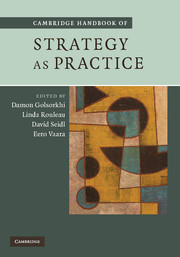Book contents
- Frontmatter
- Contents
- List of figures
- List of tables
- List of contributors
- Introduction: What is Strategy as Practice?
- PART I ONTOLOGICAL AND EPISTEMOLOGICAL QUESTIONS
- PART II THEORETICAL DIRECTIONS
- 7 Giddens, structuration theory and Strategy as Practice
- 8 An activity-theory approach to Strategy as Practice
- 9 A Bourdieusian perspective on strategizing
- 10 A Wittgensteinian perspective on strategizing
- 11 A Foucauldian perspective on strategic practice: strategy as the art of (un)folding
- 12 A narrative approach to Strategy as Practice: strategy making from texts and narratives
- PART III METHODOLOGICAL TRACKS
- PART IV APPLICATION VARIATIONS
- Author Index
- Index
- References
9 - A Bourdieusian perspective on strategizing
Published online by Cambridge University Press: 05 October 2012
- Frontmatter
- Contents
- List of figures
- List of tables
- List of contributors
- Introduction: What is Strategy as Practice?
- PART I ONTOLOGICAL AND EPISTEMOLOGICAL QUESTIONS
- PART II THEORETICAL DIRECTIONS
- 7 Giddens, structuration theory and Strategy as Practice
- 8 An activity-theory approach to Strategy as Practice
- 9 A Bourdieusian perspective on strategizing
- 10 A Wittgensteinian perspective on strategizing
- 11 A Foucauldian perspective on strategic practice: strategy as the art of (un)folding
- 12 A narrative approach to Strategy as Practice: strategy making from texts and narratives
- PART III METHODOLOGICAL TRACKS
- PART IV APPLICATION VARIATIONS
- Author Index
- Index
- References
Summary
The firm is not a homogeneous entity that can be treated as a rational subject – the ‘entrepreneur’ or the ‘management’ – oriented towards a single, unified objective. It is determined (or guided) in its ‘choice’ not only by its position in the structure of the field of production, but also by its internal structure which, as a product of all its earlier history, still orients its present […] Its strategies are determined through innumerable decisions, small and large, ordinary and extraordinary, which are, in every case, the product of the relationship between, on the one hand, interests and dispositions associated with positions in relations of force within the firm and, on the other, capacities to make those interests or dispositions count, capacities which also depend on the weight of the different agents concerned in the structure, and hence on the volume and structure of their capital. (Bourdieu 2005, p. 69)
Introduction
The French sociologist Pierre Bourdieu (1930–2002) was one of the most influential thinkers in the social sciences (Calhoun 2003). In particular, his work on practice represents a major contribution to the field. It has been used by Brown and Duguid (2001) and Lave and Wenger (1991) to define communities of practice; by Chia and MacKay (2007), Jarzabkowski (2005) and Whittington (2002) to position strategy as a practice; and by Cook and Brown (1999) and Nicolini et al. (2003) to build dynamic links between knowing and practice.
- Type
- Chapter
- Information
- Cambridge Handbook of Strategy as Practice , pp. 141 - 154Publisher: Cambridge University PressPrint publication year: 2010
References
- 29
- Cited by



